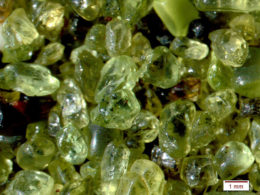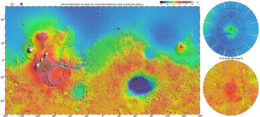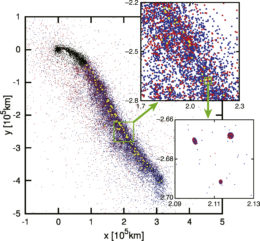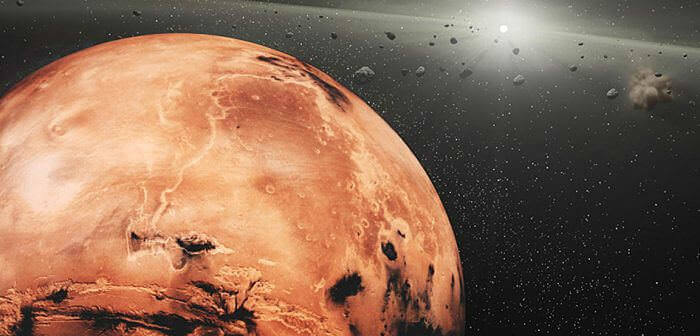Like evidence left at a crime scene, the mineral olivine may be the clue that helps scientists piece together Mars’s possibly violent history. Could a long-ago giant impact have flung pieces of Mars throughout our inner solar system? Two researchers from the Tokyo Institute of Technology in Japan are on the case.
A Telltale Mineral

Olivine, a mineral that is common in Earth’s subsurface but weathers quickly on the surface. Olivine is a major component of Mars’s upper mantle. [Wilson44691]
How did these asteroids form, and why are they so olivine-rich? An interesting explanation has been postulated: perhaps this olivine all came from the same place — Mars — as the result of a mega impact billions of years ago.
Evidence for Impact
Mars bears plenty of signs pointing to a giant impact in its past. The northern and sourthern hemispheres of Mars look very different, a phenomenon referred to as the Mars hemisphere dichotomy. The impact of a Pluto-sized body could explain the smooth Borealis Basin that covers the northern 40% of Mars’s surface.

This high-resolution topographic map of Mars reveals the dichotomy between its northern and sourthern hemispheres. The smooth region in the northern hemisphere, the Borealis basin, may have been formed when a giant object impacted Mars billions of years ago. [NASA/JPL/USGS]
To test this theory, we need to determine if a mega impact is capable of producing enough ejecta — and with the appropriate compositions and orbits — to explain the Mars trojans and the A-type asteroids we observe. Tackling this problem, researchers Ryuki Hyodo and Hidenori Genda have performed numerical simulations to explore the ejecta from such a collision.
Distributing Debris
Hyodo and Genda examine the outcomes of a Mars mega impact using smoothed particle hydrodynamics simulations. They test different impactor masses, impactor speeds, angles of impact, and more to determine how these properties affect the properties of the Martian ejecta that result.

Debris ejected in a Mars mega impact, at 20 hours post-impact. Blue particles are from the impactor, red particles are from Mars, yellow particles are clumps of >10 particles. [Hyodo & Genda 2018]
How can we further explore this picture? Debris from a Mars mega impact would not just have been the source of new asteroids; the debris likely also collided with pre-existing asteroids — or even transferred to early Earth. Signatures of a Mars mega impact may therefore be recorded in main-belt asteroids or in meteorites found on Earth, providing tantalizing targets for future studies in the effort to map out Mars’s past.
Citation
Ryuki Hyodo and Hidenori Genda 2018 ApJL 856 L36. doi:10.3847/2041-8213/aab7f0

5 Comments
Pingback: Pianeta Rosso: asteroidi da un mega impatto marziano - S.UFO
Pingback: Abril 2018 – Observatori Astronòmic
Pingback: Asteroides procedentes de un megaimpacto en Marte « SEDA / LIADA - RedLIADA - Cursos LIADA - Cielo del Mes - Fenómenos Astronómicos - RELEA
Pingback: Asteroides procedentes de un megaimpacto | Web de la Sección de Asteroides de la LIADA – Liga Iberoamericana de Astronomía.
Pingback: Asteroids from a martian mega-impact? | Red Planet Report